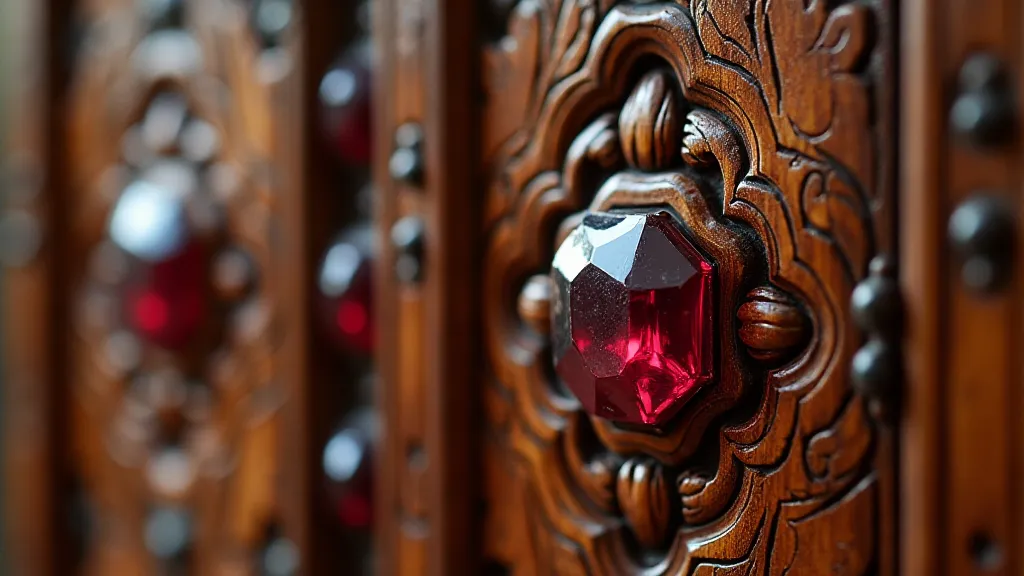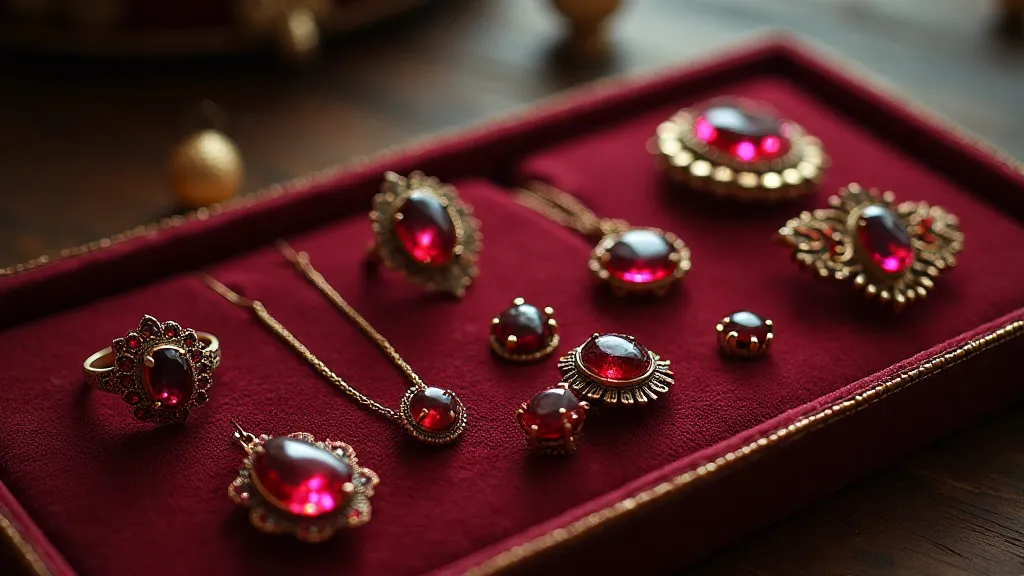The Garnet's Fire: Igniting Creativity Through Gemstone Inspiration
The garnet. Its name, derived from the Latin "granatus," meaning "seed-like," evokes images of tiny rubies scattered within a pomegranate. But the garnet is so much more than a mere resemblance. It's a stone steeped in history, folklore, and a vibrant energy that, for centuries, has drawn the eye and captivated the imagination. It's a stone, I’ve found, that can be a surprising catalyst for creativity, a silent muse for artists and writers alike. This isn't just about the stone’s beauty; it's about the resonance it holds within, a connection to the earth's slow, patient artistry, and the potential for that energy to fuel our own.
My fascination with garnets began not with a glittering jewel, but with a dusty collection of antique accordions. My grandfather, a clockmaker with a penchant for the unusual, inherited a trove of them – instruments he considered more akin to intricate mechanisms than mere musical devices. Among his hoard were several garnet-studded decorative panels, remnants from damaged or repurposed instruments. Their deep red hues, contrasting with the aged brass and wood, felt ancient, almost secretive. The way the light caught them, revealing depths of color and subtle inclusions, sparked a feeling of wonder that extended beyond mere appreciation of craftsmanship. He often spoke of the secrets hidden within geological formations and how each mineral held a story – hinting at the incredible processes that shape our planet, a notion I now understand better through explorations into topics like chromatic whispers: deciphering the language of mineral colors.

A Stone Through Time: Garnet's Historical Echoes
The garnet's story stretches back millennia. Ancient Egyptians believed garnets to be droplets of dragon’s blood – a powerful symbol of life and vitality. Roman soldiers wore them for protection and courage, believing they would ward off injury. Throughout the Middle Ages, garnets were often used in ecclesiastical jewelry and royal regalia, signifying piety and royalty. The stone was even ground into a powder and used as an early form of toothpaste, leading to the nickname "Jacob’s Stone," a reference to the biblical figure who reportedly had teeth like pearls. Considering the intricate geological processes that lead to the formation of such gemstones, one can't help but wonder about the forces at play; a deeper dive into the tumbler's rhythm: a beginner’s guide to geological choreography can offer a fascinating perspective.
This long and varied history imbues the garnet with a weight of meaning. Knowing that a stone you hold might have adorned the cloak of a Roman centurion, or graced the fingers of a medieval queen, invites a certain reverence. It connects us to a lineage of human experience, both grand and humble. This sense of connection can be incredibly powerful for any creative seeking inspiration. Consider how a writer, imagining a character from the Roman era, could draw on the garnet’s symbolism – courage, resilience, a connection to ancient traditions – to deepen the portrayal. Or how a painter, contemplating the garnet’s deep red, could channel its intensity to evoke a particular mood in a landscape.
The Garnet’s Alchemy: Color, Inclusions, and the Creative Spark
The beauty of a garnet isn't solely about its color. While most are known for their deep red hues, garnets actually occur in a surprising range of colors – orange, yellow, green, purple, and even colorless. These variations are due to trace elements within the mineral’s structure. But it's often the *inclusions* – tiny imperfections within the stone – that truly elevate its character. These aren't flaws; they’re fingerprints of the Earth's creative process, each inclusion telling a silent story of pressure, temperature, and geological time. Examining these inclusions reveals a narrative far exceeding surface aesthetics, reflecting a complex and dynamic history—similar to the way a writer refines their craft, embracing imperfections and vulnerabilities to create a truly resonant piece. It’s a parallel that mirrors from rough to radiance: the writer's journey reflected in lapidary’s art, a constant process of refinement and discovery.
For a writer, these inclusions might inspire a character’s backstory – the subtle imperfections that shape their personality. For a painter, they could translate into nuanced details within a portrait, adding depth and complexity to the subject’s expression. The garnet, in its imperfections, reminds us that beauty isn't about flawlessness; it's about authenticity, about embracing the marks that make something unique. It's about recognizing the layers of experience etched into every object, reflecting the vast history of our planet; an understanding that resonates deeply within the narratives etched into the Earth itself. The processes involved in creating these layers are intricate and profound – much like the artistry involved in crafting a compelling story.
Connecting to the Craft: Garnet in Lapidary and Jewelry Making
The lapidary arts—the processes of cutting and polishing gemstones—offer a fascinating window into the garnet’s transformation. Seeing a rough garnet, dull and unassuming, gradually revealed as a vibrant, polished gem is a testament to human skill and patience. The careful selection of the cut, the precise angles, the meticulous polishing – all contribute to the final result. And the process itself can be deeply meditative, a form of mindful creation that fosters appreciation for natural beauty. The understanding of geological time scales and the intricate processes that lead to the formation of gemstones further enriches this appreciation. It's truly a spectacle of nature’s artistry.
Similarly, the creation of jewelry incorporating garnets—whether as a simple pendant or an elaborate brooch—is a testament to human artistry. The way the stone is set, the interplay of light and shadow, the overall design—all elements contribute to a final piece that is both beautiful and meaningful. The creation of a cabochon – a rounded, polished garnet – is a particularly rewarding process for beginners in lapidary, offering a relatively simple introduction to gem cutting techniques.

Restoration and Reverence: Preserving the Past, Igniting the Future
My grandfather's accordions, many of them in various states of disrepair, provided another avenue for creative inspiration. The act of restoring them – carefully cleaning the wood, repairing the bellows, and replacing missing parts – was akin to resurrecting a forgotten history. Similarly, carefully restoring antique garnet jewelry—cleaning away the grime of centuries, reinforcing delicate settings—is an act of reverence, a way of honoring the craftsmanship of the past. The preservation of geological records, much like the restoration of antique artifacts, allows us to connect with the past and gain a deeper understanding of the forces that shape our world. Learning to interpret these records, to decipher the stories they hold, is akin to understanding the narrative embedded within a garnet itself; a reflection of geological palimpsest: reading the layers of earth’s history in a single rock.
Even the smallest detail—the warmth of the wood beneath your fingertips, the glint of the garnet reflecting light—can spark a flood of creative ideas. Perhaps a writer could draw inspiration from the intricate mechanics of the accordion, crafting a story about hidden gears and unexpected harmonies. Or perhaps a painter could capture the melancholy beauty of a forgotten instrument, a poignant reminder of time's relentless passage. Each layer of history contributes to the overall narrative, a complex interplay of cause and effect.
Collecting antique garnet jewelry or instruments can also be a rewarding pursuit, not just for the objects themselves, but for the stories they hold. Each piece is a tangible link to the past, a silent witness to history. Understanding the history and provenance of a garnet piece can enrich your appreciation for its beauty and significance. The intricacies of mineral formation and the passage of geological time create a unique story in every stone.

The history of garnet use is surprisingly extensive, evolving alongside human culture and technological advancement. From ancient Egyptian jewelry to Roman armor, garnets have served as both functional and symbolic objects, reflecting the changing values and beliefs of different societies. The journey of a garnet, from its formation deep within the Earth to its incorporation into a cherished piece of jewelry or an instrument, is a remarkable testament to the interconnectedness of nature and human creativity.
Ultimately, the garnet's fire isn't just about the stone’s color; it’s about the spark it ignites within us. It's about connecting with the earth's artistry, appreciating the skill of human craftsmanship, and embracing the power of imperfection. It's about finding inspiration in the past and using it to fuel our creative endeavors, transforming a simple gemstone into a powerful muse. The profound connection between geological processes, artistic expression, and human history serves as a constant reminder of the beauty and complexity of the world around us.





